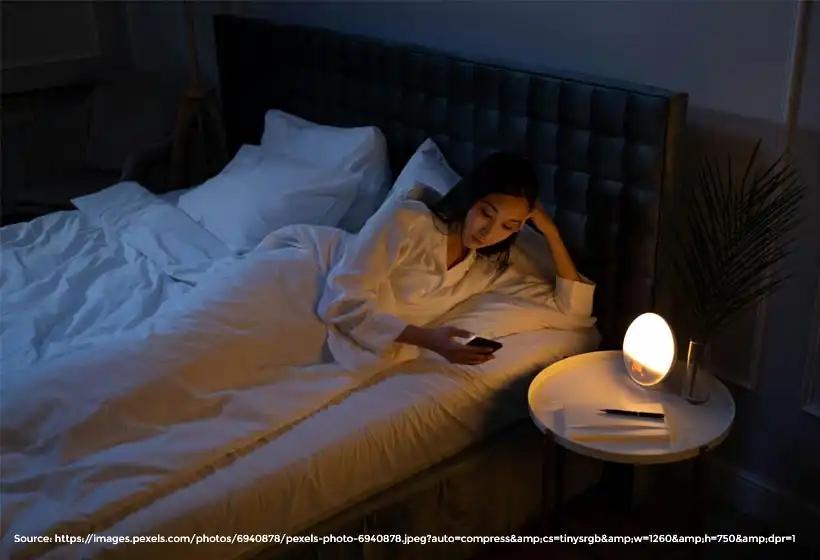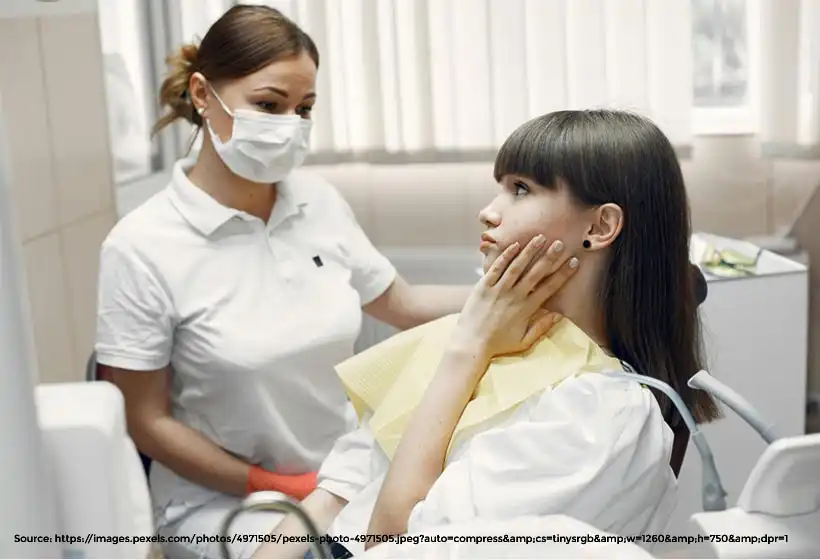Sleepless Nights? Best Treatment for Myofascial Pain Syndrome

If you’re reading this, chances are you’ve experienced facial pain at night when sleep feels almost impossible. Instead, you keep tossing, turning, and shifting positions—only to wake up feeling sore all over. I get it. I’ve been there.
Myofascial Pain Syndrome (MPS) isn’t just about sore muscles; it’s a cycle between chronic pain and restful sleep. And let me tell you—losing precious sleep over weeks can wreak havoc on your health, energy levels, and overall well-being.
But here’s the good news: I cured my myofascial pain syndrome. And, in this blog, I’ll walk you through everything I learned about Myofascial Pain Syndrome, causes, its connection to sleep, and most importantly, the best treatments that worked for me. Let me explain…
Link between Sleep Quality and Myofascial Pain Syndrome
Sleep and pain have a cyclic relationship—one fuels the other.
Poor sleep exacerbates MPS, and in turn, the pain makes sleeping quite impossible.
I remember nights when I’d fall asleep for an hour or two, only to be jolted awake by sharp, deep muscle aches near the upper mandibular joint. And the more exhausted I felt, the worse my pain got. Sound familiar?
Studies show that people suffering from chronic pain conditions, like MPS, experience fragmented sleep, delayed sleep onset, and frequent awakenings.
Sleep Disturbances in Myofascial Pain Syndrome
So, why does MPS disrupt sleep?
The answer lies in how trigger points (those painful, tight knots in your muscles) send pain signals to your brain, keeping you from reaching deep, restorative sleep stages.
For me, the worst part was the stiffness in my upper mandible that spread across my neck and shoulders. I’d wake up feeling more exhausted than when I went to bed.
And no amount of pain-mediator medicines seemed to help. Until I started making changes.
Here I’m about to share a few sleep troubles concerning sleepless nights.
- Difficulty Falling Asleep
Persistent muscle pain and trigger point discomfort making it hard to relax and initiate sleep.
- Night time Awakenings
Sudden pain flare-ups or discomfort in pressure points can disrupt sleep multiple times throughout the night.
- Non-Restorative Sleep
Even after a full night in bed, individuals wake up feeling fatigued due to poor sleep quality.
- Reduced Deep Sleep (Slow-Wave Sleep)
MPS patients often experience decreased time in deep, restorative sleep. This can in turn lead to poor muscle recovery and increased daytime exhaustion.
- Increased Light Sleep & Sleep Fragmentation
Pain can cause frequent shifts between sleep stages, preventing the body from reaching and maintaining deep sleep.
- Higher Risk of Insomnia
Chronic pain can contribute to insomnia symptoms, including prolonged wakefulness, restless sleep, and difficulty falling back asleep after waking up.
- Daytime Sleepiness & Fatigue
Poor night-time sleep results in excessive daytime drowsiness, reduced concentration, and decreased energy levels.
- Worsened Pain Perception
Lack of sleep intensifies pain sensitivity, creating a vicious cycle where poor sleep leads to more pain, and increased pain further disrupts sleep.
- Increased Stress & Anxiety
Sleep deprivation caused by MPS can heighten stress, anxiety, and irritability, further impacting overall sleep quality and pain management.
- Restless Leg Syndrome (RLS) & Muscle Twitching
Some individuals with MPS may experience involuntary muscle movements, further disturbing sleep continuity.
Individuals with MPS often experience both a decrease in the quantity and quality of sleep. The persistent pain from trigger points can make it difficult to fall asleep and stay asleep, leading to frequent awakenings during the night.
Addressing sleep disturbances is crucial in the management of MPS. Improving sleep quality can help break the pain-sleep disruption cycle. It can improve overall outcomes if you’re suffering from this condition.
Symptoms and Causes of Myofascial Pain Syndrome
Recognizing MPS symptoms is key to finding relief. Here are the classic signs I personally experienced.
- Persistent, deep muscle pain, especially in the neck, shoulders, and back
- Pain that worsens with stress or lack of sleep
- Stiffness and limited mobility
- Muscle knots or trigger points that hurt when pressed
- Frequent headaches or jaw pain
If this sounds like you, don’t ignore it. MPS often mimics other conditions, making diagnosis tricky. The sooner you address it, the better your chances of breaking free from the cycle.
Why People with Insomnia Are at Greater Risk for Myofascial Pain Syndrome

Let’s talk about insomnia. It’s not just about having trouble sleeping; it’s about the body’s inability to recover properly. People with chronic insomnia have a significantly higher risk of developing MPS.
Why? Because deep sleep is when muscles heal and repair.
When I was caught in the loop of sleepless nights and worsening pain, I realized that treating my insomnia was just as important as treating my pain. You can’t heal if your body never gets the chance to rest.
Insomnia, characterized by persistent difficulty in falling or staying asleep, has been identified as a significant risk factor for developing Myofascial Pain Syndrome (MPS). A comprehensive population-based study by the NIH revealed that individuals diagnosed with insomnia were nearly twice as likely to develop MPS compared to those without sleep disturbances.
Population-based Case Study
The study followed 1,579 patients with insomnia and 6,316 control participants over a decade. Findings indicated that the incidence of MPS was 14.9 per 1,000 person-years in the insomnia group, compared to 7.5 per 1,000 person-years in the control group. After adjusting for variables such as age, sex, income, urbanization, and comorbidities, the data showed that insomnia patients had a 1.93 times higher risk of developing MPS.
The Connection
The link between insomnia and MPS can be attributed to several factors:
- Impaired Muscle Recovery
Sleep is crucial for muscle repair and recovery. Chronic sleep deprivation can hinder the body’s ability to heal, leading to the development of trigger points characteristic of MPS.
- Heightened Pain Sensitivity
Lack of restorative sleep can lower pain thresholds, making individuals more susceptible to experiencing musculoskeletal pain.
- Stress and Muscle Tension
Insomnia often increases stress levels, which can result in muscle tension and the formation of painful knots associated with MPS.
Addressing insomnia is essential not only for improving sleep quality but also for reducing the risk of developing Myofascial Pain Syndrome. Implementing effective sleep hygiene practices, seeking cognitive-behavioral therapy for insomnia, and managing stress can play pivotal roles in preventing the onset of MPS.
Sleep-Associated Aspects of Myofascial Pain in the Orofacial Area
One of the worst surprises MPS threw at me was jaw pain. I had no idea that trigger points could cause tightness in the face and jaw—leading to tension headaches and even teeth grinding.
If you wake up with sore jaw muscles or headaches, MPS might be a potent cause. Addressing orofacial pain early can prevent long-term damage, like TMJ disorders or chronic migraines.
What is the Best Treatment for Myofascial Pain?
I tried everything—painkillers, heat therapy, massage guns, you name it. But what really made a difference was a combination of:
- Trigger Point Therapy – Massaging and applying pressure to trigger points helped break up muscle knots.
- Heat Therapy – A heating pad on sore areas before bed worked wonders.
- Stretching & Gentle Exercises – Restorative yoga and light stretching reduced stiffness.
- Quality Sleep Support – The right mattress and sleeping position made a huge impact (more on that soon).
- Magnesium Supplements – Helped relax my muscles naturally.
Can Myofascial Pain Syndrome (MPS) Be Confused with Dental Issues?

As someone who’s explored various aspects of pain management over the years, I’ve seen how Myofascial Pain Syndrome (MPS) can easily be mistaken for dental issues, especially when it affects the orofacial region.
When people experience jaw pain, facial discomfort, or a sensation similar to a toothache, it’s natural to think the problem lies with their teeth.
Unfortunately, many are left frustrated when dental treatments don’t seem to work.
Here’s why I believe MPS can be confused with dental problems:
- Jaw Pain & TMJ Disorder (TMD)
I’ve encountered several cases where MPS symptoms, especially in the jaw muscles, mimic Temporomandibular Joint Disorder (TMD). The pain, stiffness, and difficulty chewing often lead individuals to think it’s TMD, but it’s actually the muscles causing the issue.
- Toothache-Like Pain
One thing that surprised me was how trigger points in the jaw and face muscles could refer pain to the teeth. It’s a confusing experience for many, as the pain feels like a toothache, yet there’s no dental issue. This leads to unnecessary dental procedures, from fillings to root canals, without relief.
- Facial & Gum Pain
In some of my cases, I’ve seen people struggle with deep, aching pain in the face, gums, or even behind the eyes due to myofascial pain. This can resemble symptoms of sinus infections or gum disease, leading people to visit multiple specialists before discovering the real cause.
MPS often causes teeth grinding or jaw clenching, something I’ve observed in patients who come in complaining about tooth sensitivity. The grinding worsens the pain, yet they might only be given a night guard, leaving the root cause—the muscle dysfunction—untreated.
- Ear Pain & Pressure
Another interesting pattern I’ve noticed is referred pain to the ears. MPS in the face or jaw can mimic symptoms of an ear infection or Eustachian tube dysfunction, causing people to seek help from ENT specialists, when it’s really the muscles causing the discomfort.
When to Consider MPS Instead of a Dental Problem
If you’ve tried various dental treatments but still experience jaw pain, facial discomfort, or toothache-like symptoms, it might be time to think about Myofascial Pain Syndrome.
From my experience, consulting with a pain specialist or physical therapist who understands muscle-related pain, rather than just focusing on dental care, could make all the difference in getting a proper diagnosis and effective treatment.
How I Cured My Myofascial Pain Syndrome
I won’t sugarcoat it.
MPS isn’t something you cure overnight. But with the right routine, I managed to control it.
Here’s what worked for me.
- Daily stretching – Even 10 minutes of targeted stretching made a difference.
- Foam rolling & massage therapy – Painful at first, but life-changing in the long run.
- Sleep optimization – The biggest game-changer. I switched to a pressure-relieving mattress, found the best sleeping positions (below), and prioritized deep sleep.
- Hydration & nutrition – Cutting back on caffeine and increasing water intake reduced muscle stiffness.
- Stress management – Meditation, deep breathing, and reducing screen time before bed helped immensely.
Best Sleeping Positions for Myofascial Pain Syndrome
The way you sleep can either ease your pain or make it worse.
- Back Sleeping with a Pillow under the Knees – This reduced lower back strain.
- Side Sleeping with a Pillow between the Knees – Helped with shoulder and hip pain.
- Avoiding Stomach Sleeping – This aggravated my neck and back pain.
A supportive pillow and mattress are just as important—so let’s talk about that next.
Best Mattresses for Myofascial Pain Syndrome: Comfort-Zone Mattresses
I wasted years sleeping on the wrong mattress. If you have MPS, you need a mattress that:
- Relieves pressure points
- Supports spinal alignment
- Adapts to your body without sinking too much
The best options? Memory foam and hybrid mattresses.
I personally switched to a medium-firm memory foam mattress, and it greatly improved my sleep.
Some top brands to consider:
- Saatva Classic – Chiropractor-recommended for back and side sleepers
- iSense Hybrid Premier – Adjustable mattress for customizable firmness for couples
- Tempur-Pedic Adapt – Reliable pressure relief
- Purple Hybrid – Unique grid support for pain relief
If your mattress isn’t helping, it’s time for an upgrade.
Table: Best Mattresses & Sleeping Postures for Myofascial Pain Syndrome (MPS)
| Mattress Name | Type | Price for Queen Mattresses | Firmness | Key Features for MPS Relief | Warranty/Trial | Recommended Sleeping Posture |
|---|---|---|---|---|---|---|
| Saatva Classic
(4.17/5.00) |
Hybrid/Innerspring | Approx. $2000 | Plush, Medium, Firm | Lumbar-zone technology, back support, customizable firmness | Lifetime/365 Nights | Back sleeping with a pillow under the knees for spinal alignment and pressure relief |
| iSense Hybrid Premier Mattress
(4.38/5.00) |
Adjustable Hybrid | Approx. $3900 | Customizable | Customizable firmness, compatible with adjustable beds, personalized support | 10-Year/180 Nights | I would recommend it for back sleepers. As it comes with an adjustable bed frame to elevate the legs and relieve muscle tension. |
| Tempur-Pedic TEMPUR-Adapt
(4.38/5.00) |
Memory Foam | Approx. $2400 | Medium | Conforms to body shape, reduces pressure points, minimizes motion transfer | 10-Year/90 Nights | Side sleeping with a pillow between the knees to reduce pressure on hips and shoulders. |
| Purple Hybrid
(4.00/5.00) |
Hybrid | Approx.
$2300 |
Medium-Firm | Responsive grid technology, supports body contours, enhances airflow for cooling | 15-Year/120 Nights | I recommend this for side sleepers with head and leg elevation to reduce tension in trigger points |
How Can These Mattresses Help?
Finding the right mattress is crucial when dealing with Myofascial Pain Syndrome (MPS) because sleep quality directly impacts muscle recovery and pain levels.
The mattresses listed above are designed to provide pressure relief, spinal alignment, and targeted support—key factors in reducing muscle tension and preventing trigger point aggravation.
Here’s how these mattresses can help:
- Pressure Point Relief
Memory foam and hybrid mattresses contour to the body, reducing strain on sore muscles and sensitive trigger points.
- Spinal Alignment
Proper lumbar support ensures the spine remains neutral, preventing excessive muscle stress during sleep.
- Motion Isolation
If you toss and turn due to pain, mattresses with motion isolation (like memory foam) can minimize disturbances, leading to deeper rest.
- Customizable Firmness
Adjustable and hybrid models allow sleepers to fine-tune firmness levels based on their pain intensity and sleep position.
- Cooling & Breathability
Heat can exacerbate muscle tension, so models with breathable materials (like Purple Hybrid or Bear Elite Hybrid) help regulate temperature for a comfortable sleep.
By choosing the right mattress, and pairing it with the recommended sleeping postures, you can create an optimal sleep setup. This will align with your requirements to ease pain, improve muscle relaxation, and help you wake up feeling refreshed instead of stiff and sore.
Best Mattresses for Myofascial Pain Syndrome (MPS)
By choosing a mattress that caters to spinal alignment, firm support, minimal sinkage, and cooling comfort, stomach sleepers can wake up refreshed—without the stiffness and discomfort that the wrong mattress often brings.
1. Saatva Classic Mattress
Read Review
.webp)
- Spinal Alignment Support – Chiropractor-recommended for back and side sleepers, featuring lumbar-zone technology to keep the spine in proper alignment, easing muscle tension and trigger points.
- Customizable Comfort – Available in Plush, Medium, and Firm, so you can choose the right firmness based on your pain level and sleeping style.
- Cooling Features – A dual-coil system and breathable organic cotton cover ensure better airflow, preventing overheating that can worsen muscle pain.
2. iSense Hybrid Premier
Read Review

- Adjustable Firmness – Features customizable firmness levels, making it an excellent choice for couples with different comfort preferences.
- Targeted Support – Adaptive foam and individually wrapped coils help relieve pressure points and provide full-body contouring.
- Compatibility with Adjustable Beds – Works well with adjustable bases, allowing personalized sleep positions to reduce strain on sore muscles.
3. Tempur-Pedic TEMPUR-Adapt Mattress
Read Review
.webp)
- Reliable Pressure Relief – High-density memory foam adapts to your body’s shape, reducing muscle tension and relieving myofascial trigger points.
- Motion Isolation – Limits movement disturbances, ensuring uninterrupted sleep even if pain causes frequent repositioning.
- Deep Cushioning – Cradles pressure-sensitive areas (neck, shoulders, and lower back), making it ideal for side and back sleepers.
4. Purple RestorePlus Hybrid Mattress
Read Review
.webp)
- Unique Grid Support – Purple’s Hyper-Elastic Polymer Grid flexes under pressure points while keeping the rest of your body evenly supported.
- Pressure-Relieving Technology – The grid absorbs muscle tension, helping to reduce pain from tight fascia and trigger points.
- Breathable Design – Open-grid construction enhances airflow, preventing heat build-up that can worsen inflammation.
Tips to Manage Myofascial Pain Syndrome Better
If you’re struggling with MPS, here are my top tips:
1. Tip #1 – Set a Sleep Schedule
Going to bed and waking up at the same time helps regulate your sleep cycle.
2. Tip #2 – Use Heat and Cold Therapy
Alternating heat and ice packs reduces inflammation and pain.
3. Tip #3 – Stay Active, but Don’t Overdo It
Gentle movement is better than being sedentary.
4. Tip #4 – Relaxation Techniques over Hitting the Gym
Meditation, deep breathing, and progressive muscle relaxation help calm your nervous system.
5. Tip #5 – Invest in the right sleep setup
A good mattress, proper pillows, and a cool, dark room can make a world of difference.
Smart-Take!
Myofascial Pain Syndrome is tough, but with the right approach, you can get relief. Prioritizing sleep, using targeted treatments, and making small lifestyle changes transformed my nights—and my health over time.
If you’re struggling with sleepless nights due to MPS, take it one step at a time.
Start with simple steps, improve your sleep habits, find a supportive mattress, and listen to your body. You deserve restful, pain-free nights—and with the right approach, you can get there.

